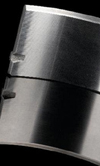Bear in mind...
 In earlier RET-Monitor articles I have written about the application and challenges of lead-free bearings. Until now the focus has been on the main bearing shells, mainly linked to the crankcase main bearing bore shape and split line quality. In this article I will put focus on the application of lead-free bearings in the small end of the con rod, as well as the design features for creating a reliable small end.
In earlier RET-Monitor articles I have written about the application and challenges of lead-free bearings. Until now the focus has been on the main bearing shells, mainly linked to the crankcase main bearing bore shape and split line quality. In this article I will put focus on the application of lead-free bearings in the small end of the con rod, as well as the design features for creating a reliable small end.
A number articles, in both Race Engine Technology magazine and here in RET-Monitor, have been published on con rods, mostly regarding overall con rod design and material. Bearings have been discussed as well, on which the absence of a small-end bearing bush was the main topic of interest, and which I believe is still not really common practice.
Let us make the step towards the lead-free bearing bushing material. As described in a previous article, lead-free bearing bushes have higher hardness compared to regular leaded bearing materials. To provide some numbers, typical leaded bearings have hardness values in the 80-120 HB range, whereas lead-free bearing materials are typically about 135 HB. In general, this means lead-free bearings have higher loadability than leaded bearings, but are less forgiving as regards conformability. Later in this article I will give an example of where this is of significant difference and where the transfer to lead-free materials could lead to engine failure if a number of design and manufacturing aspects are not properly executed.
But first I would like to discuss further the mechanism of sensitivity on bearing loads in the small-end bearing. When discussing highly loaded engines we should differentiate between two situations - loading due to combustion load, typically in turbocharged diesel engines with high peak firing pressures; and loading due to inertia load, typically in high-revving gasoline engines
Regardless of the type of loading, it will lead to bending/deformation of the piston pin, resulting in an oval shape of the pin. In severe cases, the amount of deformation can be such that the pin can no longer move freely in the small-end bearing bush. This will almost always result in damage to the small-end bearing, and hence total engine failure.
To overcome this a typical solution is to give the small end a so-called trumpet shape, which can be done by precision machining after installing the bearing bush. During this operation on the small-end bore, a somewhat larger diameter (about 5-6 microns) will be machined towards the outside of the bore. The exact final shape needs to be tailored to the specific situation, by means of determining an initial geometry by Finite Element Analysis, after which engine testing and small-end bore measurements will be used to make final adaptations at a detailed level.
What can be observed during engine inspection after an engine run is that the edges of the small-end bore have become dark. As a rule of thumb, the trumpet shape is correct if the outer couple of millimetres show an even and supported area of contact, not a line contact.
When transferring to lead-free bearings the detailed geometry and machining quality of the small-end bore shape is of major importance. Due to the fact that the hardness of the material is higher, it takes more time to run-in properly. Running-in protocols are known to have been adapted to longer duration in combination with lower loads when using lead-free bearing bushes. All this is done in order to give the components more time to adapt to their final shape.
There are two other areas of attention when looking at the trumpet shape that are more critical using lead-free bearing materials - the 'waviness' of the bore shape and the radial machining grooves in the bearing bore.
Both of these will lead to local contact between piston pin and bearing. A difficulty with these parameters is that the con rod might be within its drawing specifications and tolerances, where these local deficits, not separately specified, might lead to engine failures. Typical failures can include rotation of the bearing in the bore, loss of bearing material, deformation of the bearing, excessive heat generation and damage to the piston pin and piston bearing bores.
It is in these circumstances that the lead in leaded bearing materials still has the advantage due to its self-contained lubrication and conformability properties.
Written by Dieter van der Put